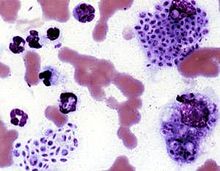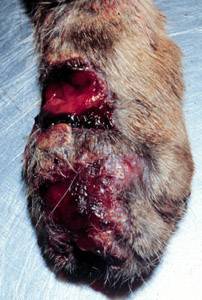Sporotrichosis
| Sporotrichosis | |
|---|---|
| Other names | Rose thorn disease, rose gardener's disease,[1]rose handler's disease[2] |
 | |
| Cytologic preparation from a case of feline sporotrichosis; phagocytic cells show numerous variably-shaped yeast forms within | |
| Specialty | Infectious disease |
| Symptoms | Firm painlessnodulesthat laterulcerate.[3] |
| Causes | Sporothrix schenckii[1] |
| Diagnostic method | |
| Differential diagnosis | Leishmaniasis,nocardiosis,mycobacterium marinum,[3]cat-scratch disease,syphilis,leprosy,sarcoidosis,tuberculosis[1] |
| Treatment | Antifungals,surgery[1] |
| Medication | Itraconazole,posaconazole,amphotericin B[1] |
| Prognosis | Good with treatment, poor if widespread disease[1] |
Sporotrichosis,also known asrose handler's disease,[2]is afungal infectionthat may be localised to skin, lungs, bone and joint, or becomesystemic.[2][4]It presents with firm painlessnodulesthat laterulcerate.[3]Following initial exposure toSporothrix schenckii,the disease typically progresses over a period of a week to several months.[1]Serious complications may develop in people who have aweakened immune system.[1]
Sporotrichosis is caused by fungi of theS. schenckiispecies complex.[5][6]BecauseS. schenckiiis naturally found in soil,hay,sphagnum moss,and plants, it most often affectsfarmers,gardeners, and agricultural workers.[7]It enters through small cuts in the skin to cause a fungal infection.[1]In cases of sporotrichosis affecting the lungs, the fungal spores enter byinhalation.[1]Sporotrichosis can be acquired by handling cats with the disease; it is an occupational hazard for veterinarians.[1]
Treatment depends on the site and extent of infection.[1]Topical antifungalsmay be applied to skin lesions.[1]Deep infection in the lungs may require surgery.[1]Systemic medicationsused includeItraconazole,posaconazoleandamphotericin B.[1]With treatment, most people will recover,[1]but an immunocompromised status and systemic infection carry a worse prognosis.[1]
S. schenkii,the causal fungus, is found worldwide.[1]The species was named for Benjamin Schenck, a medical student who, in 1896, was the first to isolate it from a human specimen.[8]
Sporotrichosis has been reported in cats,[1]mules, dogs, mice and rats.[3]
Signs and symptoms
[edit]
- Cutaneous or skin sporotrichosis
- This is the most common form of this disease. Symptoms of this form include nodularlesionsor bumps in the skin, at the point of entry and also alonglymphnodes and vessels. The lesion starts off small and painless, and ranges in color from pink to purple. Left untreated, the lesion becomes larger and look similar to aboiland more lesions will appear, until a chroniculcerdevelops.[citation needed]
- Usually, cutaneous sporotrichosis lesions occur in the finger, hand, and arm.[citation needed]
- Pulmonary sporotrichosis
- This rare form of the disease occurs whenS. schenckiispores are inhaled. Symptoms ofpulmonarysporotrichosis include productivecoughing,nodules and cavitations of the lungs,fibrosis,and swollenhilarlymph nodes.Patients with this form of sporotrichosis are susceptible to developingtuberculosisandpneumonia[citation needed]
- Disseminated sporotrichosis
- When the infection spreads from the initial site to secondary sites in the body, the disease develops into an uncommon and potentially life-threatening form, calleddisseminatedsporotrichosis. The infection can spread to joints and bones (calledosteoarticular sporotrichosis) as well as thecentral nervous systemand the brain (calledsporotrichosis meningitis).[citation needed]
- Some symptoms of disseminated sporotrichosis include weight loss,anorexia,and bone lesions.
Complications
[edit]Open sporotrichosis lesions on the skin will on occasion becomesuperinfectedwith bacteria.[9]Cellulitismay also occur.[9]
Diagnosis
[edit]
Sporotrichosis is anacuteinfection with slow progression and often subtle symptoms. It is often difficult to diagnose, as many other diseases share similar symptoms and therefore must be ruled out.[citation needed]
Patients with sporotrichosis will haveantibodiesagainst the fungusS. schenckii;however, due to variability in sensitivity and specificity, antibody detection may not be a reliable diagnostic test for this disease. The confirming diagnosis remainsculturingthe fungus from the skin,sputum,synovial fluid,andcerebrospinal fluid.Smearsshould be taken from any drainingfistulasor ulcers.[citation needed]
Cats with sporotrichosis are unique in that theexudatefrom their lesions may contain numerous infectious organisms. This makes cytological evaluation of exudate a valuable diagnostic tool in this species. Exudate ispyogranulomatous,andphagocytic cellsmay be packed withyeast forms.These yeast cells are variable in size; many are cigar-shaped.[citation needed]
Differential diagnosis
[edit]Differential diagnoses includes:leishmaniasis,nocardiosis,mycobacterium marinum,[3]cat-scratch disease,leprosy,syphilis,sarcoidosisandtuberculosis.[1]
Prevention
[edit]The majority of sporotrichosis cases occur when the fungus is introduced through a cut or puncture in the skin while handling vegetation containing the fungal spores. Prevention of this disease includes wearing long sleeves and gloves while working with soil, hay bales, rose bushes, pine seedlings, and sphagnum moss.
The risk of sporotrichosis in cats is increased in male cats that roam outdoors.[10]Accordingly, the risk may be reduced by keeping cats indoors or neutering them.[11]Isolating infected animals can also be a preventive measure.[11][12]The risk of spread from infected cats to humans can be reduced by appropriate biosafety measures, including wearingpersonal protective equipmentwhen handling a cat with suspected sporotrichosis and by washing hands, arms and clothing after handling the cat.[12]
Treatment
[edit]Treatment of sporotrichosis depends on the severity and location of the disease. The following are treatment options for this condition:[13]
- Oralpotassium iodide
- Potassium iodide is an anti-fungal drug that is widely used as a treatment for cutaneous sporotrichosis. Despite its wide use, there is no high-quality evidence for or against this practice. Further studies are needed to assess the efficacy and safety of oral potassium iodide in the treatment of sporotrichosis.[14]
- Itraconazole(Sporanox) andfluconazole
- These areantifungaldrugs. Itraconazole is currently the drug of choice and is significantly more effective than fluconazole. Fluconazole should be reserved for patients who cannot tolerate itraconazole.
- This antifungal medication is delivered intravenously. Many patients, however, cannot tolerate Amphotericin B due to its potential side effects of fever, nausea, and vomiting.
- Lipid formulations of amphotericin B are usually recommended instead ofamphotericin B deoxycholatebecause of a better adverse-effect profile. Amphotericin B can be used for severe infection during pregnancy. For children with disseminated or severe disease, amphotericin B deoxycholate can be used initially, followed by itraconazole.[15]
- In case of sporotrichosis meningitis, the patient may be given a combination of Amphotericin B and 5-fluorocytosine/Flucytosine.
- 500mg and 1000mg daily dosages of terbinafine for twelve to 24 weeks has been used to treat cutaneous sporotrichosis.[16]
- Newertriazoles
- Several studies have shown thatposaconazolehas in vitro activity similar to that of amphotericin B and itraconazole; therefore, it shows promise as an alternative therapy. However,voriconazolesusceptibility varies. Because the correlation between in vitro data and clinical response has not been demonstrated, there is insufficient evidence to recommend either posaconazole or voriconazole for treatment of sporotrichosis at this time.[15]
- In cases of bone infection and cavitary nodules in the lungs, surgery may be necessary.
- Heat creates higher tissue temperatures, which may inhibit fungus growth while the immune system counteracts the infection. The "pocket warmer" used for this purpose has the advantage of being able to maintain a constant temperature of 44 degrees-45 degrees C on the skin surface for several hours, while permitting unrestricted freedom of movement. The duration of treatment depends on the type of lesion, location, depth, and size. Generally, local application for 1-2 h per day, or in sleep time, for 5-6 weeks seems to be sufficient.[17]
Other animals
[edit]
Sporotrichosis can be diagnosed in domestic and wild mammals. In veterinary medicine it is most frequently seen in cats and horses. Cats have a particularly severe form of cutaneous sporotrichosis. Infected cats may exhibit abscesses, cellulitis, or draining wounds that fail to respond to antibiotic treatment.[10]
Sporotrichosis can spread from nonhuman animals to humans (zoonosis). Infected cats in particular exude large quantities ofSporothrixorganisms from their skin leasions and can spread the infection to people who handle them.[10][18]Although cats are the most common animal source, the infection has also been known to spread to humans from dogs, rats, squirrels, and armadillos.[19]
See also
[edit]References
[edit]- ^abcdefghijklmnopqrstuvMilner, Dan A.; Solomon, Isaac (2020)."Sporotrichosis".In Milner, Danny A. (ed.).Diagnostic Pathology: Infectious Diseases.Elsevier. pp. 316–319.ISBN978-0-323-61138-1.
- ^abcProia, Laurie (2020)."28. The dimorphic mycoses".In Spec, Andrej; Escota, Gerome V.; Chrisler, Courtney; Davies, Bethany (eds.).Comprehensive Review of Infectious Diseases.Elsevier. pp. 421–422.ISBN978-0-323-56866-1.
- ^abcdeJames, William D.; Elston, Dirk; Treat, James R.; Rosenbach, Misha A.; Neuhaus, Isaac (2019)."13. Diseases resulting from fungi and yeasts".Andrews' Diseases of the Skin: Clinical Dermatology(13th ed.). Elsevier. pp. 314–315.ISBN978-0-323-54753-6.
- ^Johnstone, Ronald B. (2017)."25. Mycoses and Algal infections".Weedon's Skin Pathology Essentials(2nd ed.). Elsevier. p. 455.ISBN978-0-7020-6830-0.
- ^"ICD-11 - ICD-11 for Mortality and Morbidity Statistics".icd.who.int.Retrieved11 July2021.
- ^López-Romero, Everardo; et al. (2010). "Sporothrix schenckii complex and sporotrichosis, an emerging health problem".Future Microbiology.6(1): 85–102.doi:10.2217/fmb.10.157.PMID21162638.
- ^Ryan KJ, Ray CG, eds. (2004).Sherris Medical Microbiology(4th ed.). McGraw Hill. pp.654–6.ISBN978-0-8385-8529-0.
- ^Barros MB, de Almeida Paes R, Schubach AO (October 2011)."Sporothrix schenckii and Sporotrichosis".Clinical Microbiology Reviews.24(4): 633–54.doi:10.1128/CMR.00007-11.PMC3194828.PMID21976602.
- ^abProcop, Gary W.; et al. (2020).Koneman's Color Atlas and Textbook of Diagnostic Microbiology.Jones & Bartlett Learning. p. 1377.ISBN9781284322378.
- ^abcBirchard, Stephen J.; Sherding, Robert G. (2005).Saunders Manual of Small Animal Practice(3rd ed.). Elsevier Health Sciences. p. 440.ISBN9781416064299.
- ^abSykes, Jane E. (2013).Canine and Feline Infectious Diseases.Elsevier Health Sciences. p. 629.ISBN9780323241946.
- ^abSykes, Jane E. (2022).Greene's Infectious Diseases of the Dog and Cat.Elsevier Health Sciences. p. 1054.ISBN9780323509336.
- ^Lortholary O, Denning DW, Dupont B (March 1999)."Endemic mycoses: a treatment update".The Journal of Antimicrobial Chemotherapy.43(3): 321–31.doi:10.1093/jac/43.3.321.PMID10223586.
- ^Xue S, Gu R, Wu T, Zhang M, Wang X (October 2009)."Oral potassium iodide for the treatment of sporotrichosis".The Cochrane Database of Systematic Reviews.2009(4): CD006136.doi:10.1002/14651858.CD006136.pub2.PMC7388325.PMID19821356.
- ^abHogan BK, Hospenthal DR (March 2011)."Update on the therapy for sporotrichosis".Patient Care.22:49–52. Archived fromthe originalon 2020-05-22.Retrieved2019-05-05.
- ^Chapman SW, Pappas P, Kauffmann C, Smith EB, Dietze R, Tiraboschi-Foss N, Restrepo A, Bustamante AB, Opper C, Emady-Azar S, Bakshi R (February 2004). "Comparative evaluation of the efficacy and safety of two doses of terbinafine (500 and 1000 mg day(-1)) in the treatment of cutaneous or lymphocutaneous sporotrichosis".Mycoses.47(1–2): 62–8.doi:10.1046/j.1439-0507.2003.00953.x.hdl:2027.42/74074.PMID14998402.S2CID7319396.
- ^Takahashi S, Masahashi T, Maie O (October 1981). "[Local thermotherapy in sporotrichosis]".Der Hautarzt; Zeitschrift für Dermatologie, Venerologie, und Verwandte Gebiete(in German).32(10): 525–8.PMID7298332.
- ^"Sporotrichosis".The Merck Veterinary Manual.Retrieved2019-06-17.
- ^Carpouron, Julia E.; et al. (2022)."Emerging Animal-Associated Fungal Diseases".Journal of Fungi.8(6): 611.doi:10.3390/jof8060611.PMC9225262.PMID35736094.
